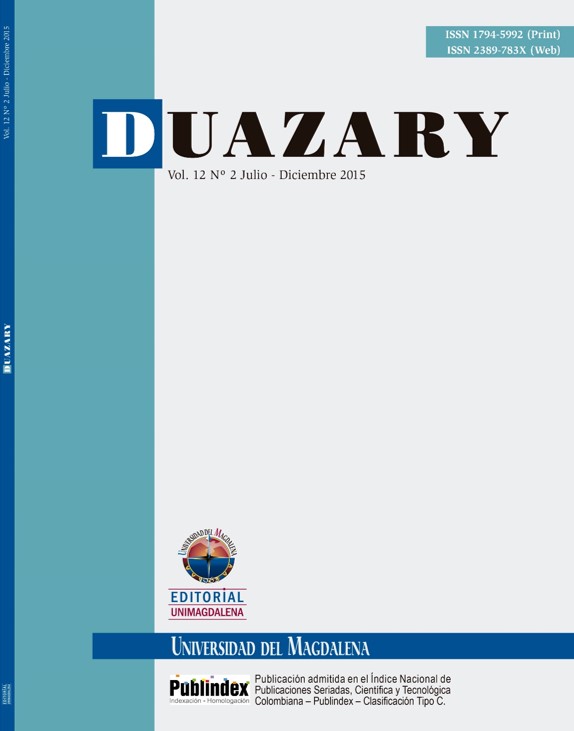Quality of life and treatment adherence in Parkinson’s disease patients
Main Article Content
Abstract
Downloads
Article Details
References
The World Health Organization Quality of Life assessment (WHOQOL): position paper from the World Health Organization. SocSci Med. 1995; 41(10):1403-9.
Bergner M, Bobbitt RA, Kressel S, Pollard WE, Gilson BS, Morris JR. The sickness impact profile: conceptual formulation and methodology for the development of a health status measure. Int J Health Serv. 1976; 6 (3): 393-415.
Karlsen KH, Larsen JP, Tandberg E, Maland JG. Quality of life measurements in patients with Parkinson's disease: A community-based study. Eur J Neurol. 1998; 5 (5): 443-50.
Ware JE, Jr., Sherbourne CD. The MOS 36-item short-form health survey (SF-36). I. Conceptual framework and itemselection. Med Care. 1992; 30 (6): 473-83.
Martínez-Lapiscina E, Pulido-Fontes L, Erro-Aguirre ME. Manejo terapéutico de las fluctuaciones motoras en la enfermedad de Parkinson. Rev Neurol. 2012; 54 (Suppl 5): S25-S32.
Peto V, Jenkinson C, Fitzpatrick R. PDQ-39: a review of the development, validation and application of a Parkinson's disease quality of life questionnaire and its associated measures. J Neurol. 1998; 245 (Suppl 1): S10-4.
Bushnell DM, Martin ML. Quality of life and Parkinson's disease: translation and validation of the US Parkinson's Disease Questionnaire (PDQ-39). Qual Life Res.1999; 8, 345-50.
Jenkinson C, Fitzpatrick R, Peto V, Greenhall R, & Hyman N. The Parkinson's Disease Questionnaire (PDQ-39): development and validation of a Parkinson's disease summary index score. Age Ageing. 1997; 26, 353-7.
Martinez-Martin P, FradesPayo B. Quality of life in Parkinson's disease: validation study of the PDQ-39 Spanish version. The Grupo Centro for Study of Movement Disorders. J Neurol. 1998; 245 (Suppl 1): S34-8.
Rigueira García AI. Cumplimiento terapéutico ¿qué conocemos en España? Atención Primaria, 2001; 27 (8): 559-68.
Sackett DL, Haynes RB, Gibson ES, Hackett BC, Taylor DW, Roberts RS, et al. Randomised clinical trial of strategies for improving medication compliance in primary hypertension. Lancet. 1975; 1 (7918): 1205-7.
Elm JJ, Kamp C, Tilley BC, Guimaraes P, Fraser D, Deppen P, et al. Self-reported adherence versus pill count in Parkinson's disease: the NET-PD experience. Mov Disord. 2007; 22 (6): 822-7.
Grosset D. Therapy adherence issues in Parkinson's disease. J Neurol Sci. 2010; 289 (1-2): 115-8.
Grosset KA, Bone I, Reid JL, Grosset D. Measuring therapy adherence in Parkinson's disease: a comparison of methods. J Neurol Neurosurg Psychiatry. 2006; 77 (2): 249-51.
Morisky DE, Green LW, Levine DM. Concurrent and predictive validity of a self-reported measure of medication adherence. Med Care. 1986; 24 (1): 67-74.
Forsaa EB, Larsen JP, Wentzel-Larsen T, Herlofson K, Alves G. Predictors and course of health-related quality of life in Parkinson's disease. Mov Disord. 2008; 23 (10): 1420-7.
Rodriguez-Violante M, Cervantes-Arriaga A, Corona T, Martinez-Ramirez D, Morales-Briceno H, Martinez-Martin P. Clinical determinants of health-related quality of life in Mexican patients with Parkinson's disease. Arch Med Res. 2013; 44 (2): 110-4.
Carod-Artal FJ, Vargas AP, Martinez-Martin P. Determinants of quality of life in Brazilian patients with Parkinson's disease. Mov Disord. 2007;22 (10): 1408-15.
Navarro-Peternella FM, Marcon SS. Quality of life of a person with Parkinson's disease and the relationship between the time of evolution and the severity of the disease. Rev Lat Am Enfermagem.2012; 20 (2): 384-91.
Lee VW, Pang KK, Hui KC, Kwok JC, Leung SL, Yu DS, et al. Medication adherence: Is it a hidden drug-related problem in hidden elderly? Geriatr Gerontol Int. 2013; 13(4):978-85.
Markotic F, Cerni Obrdalj E, Zalihic A, Pehar R, Hadziosmanovic Z, Pivic G, et al. Adherence to pharmacological treatment of chronic nonmalignant pain in individuals aged 65 and older. Pain Med. 2013; 14 (2): 247-56.
Valldeoriola F, Coronell C, Pont C, Buongiorno MT, Camara A, Gaig C, et al. Socio-demographic and clinical factors influencing the adherence to treatment in Parkinson's disease: the ADHESON study. Eur J Neurol. 2011; 18 (7): 980-7.
Pfeiffer RF. Parkinson disease. Nonmotor symptoms in Parkinson disease: the PRIAMO study. Nat Rev Neurol. 2009; 5 (10): 531-2.

